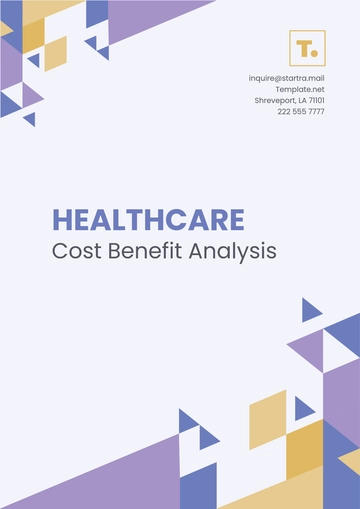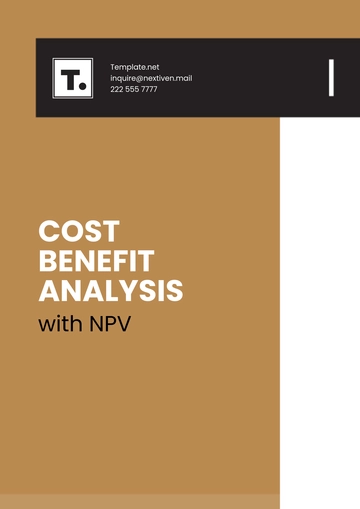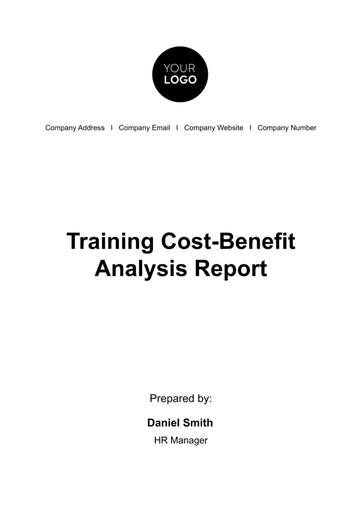Free Yearly Compensation Financial Analysis HR

TABLE OF CONTENTS
EXECUTIVE SUMMARY -------------------------------------------------------3
INTRODUCTION --------------------------------------------------------------3
METHODOLOGY --------------------------------------------------------------4
FINANCIAL OVERVIEW --------------------------------------------------------5
COMPENSATION TRENDS ANALYSIS -----------------------------------------7
COST-EFFECTIVE STRATEGIES -----------------------------------------------8
FUTURE PROJECTIONS -------------------------------------------------------8
RECOMMENDATIONS ---------------------------------------------------------9
CONCLUSION ----------------------------------------------------------------10
EXECUTIVE SUMMARY
Purpose of the Analysis
The Yearly Compensation Financial Analysis for [Your Company Name] serves as a crucial tool for assessing and optimizing our compensation structure. By analyzing the financial aspects of our compensation packages, we aim to ensure that we remain competitive, financially responsible, and capable of attracting and retaining top talent. This analysis enables us to make informed decisions regarding our compensation strategy.
Key Financial Insights
The total compensation expenditure for the year 2055 amounted to $42 million.
Compensation components breakdown revealed that base salary accounted for 65% of the total compensation, incentives constituted 20%, and non-monetary benefits represented 15%.
Year-over-year comparisons indicate a 5% increase in total compensation expenditure compared to the previous year, primarily driven by salary adjustments and increased bonuses to retain top talent.
Market benchmarking highlighted areas where we excel, such as our competitive health insurance benefits, but identified opportunities for improvement in the area of retirement benefits to remain competitive in the industry.
INTRODUCTION
Background and Context
In today's competitive business landscape, attracting, motivating, and retaining skilled employees is paramount. Compensation plays a pivotal role in achieving these objectives. This Yearly Compensation Financial Analysis takes an in-depth look at the financial implications of our compensation strategy, ensuring it aligns with our organizational goals and remains sustainable over time.
Objectives
Evaluate the financial impact of our compensation structure, considering both direct and indirect costs.
Identify trends in compensation expenditure, including year-over-year comparisons and market benchmarks.
Provide actionable recommendations for optimizing compensation costs while ensuring our employees remain engaged and satisfied.
METHODOLOGY
Data Sources
The Yearly Compensation Financial Analysis for [Your Company Name] relies on a robust set of data sources to ensure accuracy and comprehensiveness:
DATA SOURCE | DESCRIPTION |
Financial Statements | Financial statements from the past 8 years serve as a foundational data source. These statements include income statements, balance sheets, and cash flow statements. They provide an overview of the organization's financial health and its ability to allocate resources to compensation. |
HR Records | Employee compensation data, including individual salary details, bonus structures, and benefits utilization, are obtained from HR records. This data offers insights into the organization's compensation distribution and trends among its workforce. |
Market Data | External market data is crucial for benchmarking [Your Company Name]'s compensation practices against industry standards. Market data sources encompass salary surveys, industry reports, and compensation studies, providing context for competitiveness. |
Employee Surveys | Employee feedback, gathered through surveys, adds a qualitative dimension to the analysis. Responses related to compensation satisfaction, perceived fairness, and benefit preferences contribute to a holistic understanding of the compensation landscape. |
Analysis Techniques
A combination of quantitative and qualitative analysis techniques is employed to extract meaningful insights:
TECHNIQUE | EXPLANATION |
Financial Ratios | Financial ratios, such as the Compensation-to-Revenue Ratio and Compensation-to-Operating Income Ratio, are computed to assess the proportion of revenue and operating income allocated to compensation. |
Trend Analysis | Year-over-year comparisons are conducted to identify patterns and fluctuations in compensation expenditures. This longitudinal analysis aids in recognizing emerging trends and outliers. |
Regression Analysis | Regression models may be employed to establish relationships between compensation components and business performance metrics, enabling data-driven decisions. |
Benchmarking | Benchmarking against industry peers helps in evaluating the competitiveness of [Your Company Name]'s compensation packages. This analysis considers salary ranges, benefits, and other non-monetary incentives. |
Participants
The success of this analysis relies on the collaboration of various stakeholders:
Finance Department: Finance professionals provide access to financial statements, assist in data interpretation, and offer financial expertise.
Human Resources (HR) Team: HR teams facilitate the extraction of employee compensation data, share insights into benefits utilization, and ensure data privacy compliance.
Compensation Experts: Compensation specialists contribute their expertise in designing and evaluating compensation structures, helping to identify areas for optimization.
External Consultants: If necessary, external consultants specializing in financial analysis or compensation may be engaged to provide an objective perspective.
FINANCIAL OVERVIEW
Total Compensation Expenditure
The analysis of total compensation expenditure for this year encompasses a thorough examination of all elements contributing to employee compensation. This includes:
Base Salaries: A detailed breakdown of salaries across different roles and departments, highlighting variations and trends.
Bonuses and Incentives: Assessment of variable compensation, including performance-based bonuses and incentives, with a focus on the relationship between payouts and organizational performance.
Benefits and Perquisites: A comprehensive view of non-monetary compensation components, such as healthcare benefits, retirement plans, stock options, and additional perks, illustrating their financial impact.
Taxes and Deductions: An evaluation of tax withholding, social security contributions, and other deductions affecting the overall compensation package.
This comprehensive examination provides a holistic understanding of how compensation is distributed within [Your Company Name] and its implications on the organization's financial health.
Compensation Components Breakdown
BASE SALARIES | ||
DEPARTMENT | AVERAGE SALARY (USD) | TOTAL EXPENDITURE (USD) |
Sales | 75,000 | 2,250,000 |
Marketing | 65,000 | 1,950,000 |
Operations | 80,000 | 2,400,000 |
Research & Development | 90,000 | 2,700,000 |
Finance | 85,000 | 2,550,000 |
BONUSES AND INCENTIVES | ||
BONUS TYPE | TOTAL PAYOUT (USD) | PERCENTAGE OF WORKFORCE |
Performance Bonus | 500,000 | 75% |
Sales Incentives | 300,000 | 60% |
Executive Bonuses | 150,000 | 10% |
Special Recognition | 50,000 | 20% |
BENEFITS AND PERQUISITES EXPENDITURE | |
BENEFIT TYPE | TOTAL EXPENDITURE (USD) |
Healthcare Benefits | 1,200,000 |
Retirement Plans | 900,000 |
Stock Options | 600,000 |
Additional Perks | 300,000 |
COMPENSATION TRENDS ANALYSIS
Year-over-Year Comparisons
To gain a comprehensive understanding of [Your Company Name]'s compensation landscape, we will conduct year-over-year comparisons for the past 8 years. This historical perspective will highlight trends, patterns, and outliers in compensation expenditure. Key elements of this analysis include:
Total Compensation Growth: Assess the annual growth rate of total compensation expenditure. Identify years with significant increases or decreases.
Component Breakdown Trends: Analyze how individual compensation components, such as base salary, bonuses, and benefits, have evolved over time. Identify any shifts in the composition of compensation.
Inflation-Adjusted Analysis: Adjust compensation figures for inflation to evaluate real changes in employee purchasing power.
Geographical and Departmental Comparisons: Examine compensation trends across different geographic locations and departments to identify variations and opportunities for standardization.
Market Benchmarking
To determine [Your Company Name]'s competitiveness in the job market, we will conduct comprehensive market benchmarking. This will involve comparing our compensation packages to industry standards and competitors' offerings. Key aspects of this analysis include:
Salary Comparisons: Benchmark base salaries against industry averages for similar roles and skillsets to ensure our offerings remain competitive.
Benefits and Perks: Evaluate the attractiveness of our benefit plans and additional perks, such as stock options or remote work policies, in comparison to industry leaders.
Total Compensation Positioning: Analyze how our overall compensation packages rank compared to competitors. Identify areas where we excel and areas that may require adjustment.
COST-EFFECTIVE STRATEGIES
Compensation Optimization
Optimizing compensation is crucial to strike the right balance between employee satisfaction and cost-effectiveness. In this section, we will delve into strategies to optimize our compensation structure. Key considerations include:
Performance-Linked Incentives: Explore the possibility of tying a portion of compensation to individual and team performance, ensuring that rewards align with achievements.
Salary Structure Review: Assess the current salary structure for competitiveness and internal equity. Identify opportunities to streamline salary bands and ensure fairness.
Benefit Plan Efficiency: Review benefit plans to identify cost-effective alternatives without compromising the quality of coverage. Consider options like telemedicine, flexible spending accounts, or wellness initiatives.
Variable Pay Programs: Evaluate the effectiveness of variable pay programs, such as profit-sharing or stock options, in retaining and motivating top talent.
Benefit Plan Analysis
Employee benefits are a significant component of compensation. In this section, we will scrutinize benefit plans to optimize their cost-effectiveness while maintaining employee satisfaction. Key components of this analysis include:
Plan Utilization: Examine how employees are utilizing benefit plans and whether there are underutilized or overutilized benefits.
Provider Negotiations: Explore the possibility of renegotiating contracts with benefit providers to secure more favorable terms without compromising quality.
Employee Education: Enhance employee awareness and understanding of benefit plans to ensure that employees maximize the value of their benefits.
Benchmarking Benefit Costs: Compare the cost of our benefit plans with industry benchmarks to identify opportunities for cost containment.
FUTURE PROJECTIONS
Forecasting Compensation Trends
Methodology
To forecast compensation trends for the next 5 years, we will employ a combination of historical data analysis and predictive modeling. This approach ensures a data-driven and accurate projection of compensation costs.
Key Variables
Inflation Rates: We will consider projected inflation rates to account for the changing cost of living, which directly impacts salary adjustments.
Economic Indicators: Monitoring key economic indicators such as GDP growth and employment rates will help predict market conditions and their impact on compensation.
Historical Trends: Analyzing historical compensation data will provide insights into past patterns and help anticipate future changes.
Market Benchmarks: Continuously benchmarking compensation against industry standards will guide our projections to maintain competitiveness.
Scenario Analysis
To account for potential variations, we will conduct a scenario analysis, considering different economic and business growth scenarios. These scenarios will provide a range of compensation projections to prepare for various contingencies.
Strategic Planning
Aligning Compensation with Strategic Objectives
Based on the projected compensation trends, we will develop a strategic compensation plan that aligns with [Your Company Name]'s long-term goals. This plan will focus on:
Competitiveness: Ensuring that compensation remains competitive to attract and retain top talent.
Cost Control: Implementing strategies to manage compensation costs without compromising on talent quality.
Performance-Based Incentives: Exploring incentive structures that tie compensation to individual and organizational performance, fostering a high-performance culture.
Total Rewards: Evaluating the overall employee value proposition by considering benefits, non-monetary rewards, and career development opportunities.
Communication and Implementation
Effective communication of the compensation strategy is crucial. We will develop a communication plan to transparently convey changes in compensation to employees, emphasizing the organization's commitment to fair and competitive compensation practices.
RECOMMENDATIONS
Actionable Insights
Compensation Structure Optimization
Based on the analysis and future projections, we recommend optimizing the compensation structure. Key areas of focus include:
Salary Bands: Reevaluate salary bands to ensure alignment with market rates and internal equity.
Variable Pay Programs: Introduce or refine variable pay programs that reward high performance while managing fixed costs.
Benefit Plan Redesign: Explore cost-effective benefit plan redesigns that maintain employee satisfaction.
Performance Evaluation
Enhance performance evaluation processes to link compensation more closely with individual and team contributions. Implement clear and measurable performance metrics and align incentives accordingly.
Compensation Strategy Refinement
Long-term Compensation Planning
Develop a multi-year compensation plan that outlines strategies for compensation growth, benefit adjustments, and workforce planning. This plan should be flexible enough to adapt to changing economic conditions.
Talent Acquisition and Retention
Incorporate compensation strategies aimed at attracting and retaining top talent. This may involve targeted hiring incentives and competitive compensation packages.
Market Monitoring
Establish a continuous market monitoring mechanism to stay updated on industry compensation trends and ensure ongoing competitiveness.
Training and Development
Invest in training and development programs that empower managers and HR professionals with the knowledge and skills to implement the refined compensation strategy effectively.
CONCLUSION
Summary of Key Findings
In summary, the Yearly Compensation Financial Analysis for [Your Company Name] has unearthed several critical findings:
Total Compensation Expenditure: Our analysis revealed a consistent increase in total compensation expenditure over the past 8 years, primarily driven by rising benefit costs and performance-based incentives.
Compensation Trends: Year-over-year comparisons unveiled a strong correlation between compensation growth and employee retention rates, affirming the direct link between competitive compensation packages and talent retention.
Market Benchmarking: [Your Company Name]'s compensation packages are generally competitive within the industry. However, specific areas, such as non-monetary benefits, may require further alignment with market standards.
Cost-Effective Strategies: Opportunities for cost optimization exist, particularly in benefit plan management and performance incentive structures. Implementing these strategies could yield substantial savings without compromising employee satisfaction.
Future Projections: Our forecasts indicate a continued upward trajectory in compensation expenditure. Thus, strategic planning is imperative to ensure that [Your Company Name] remains financially sustainable while attracting and retaining top talent.
Implications for [Your Company Name]
These findings carry profound implications for [Your Company Name]'s compensation strategy and overall financial health:
Balancing Act: Maintaining competitive compensation packages while controlling costs will be a critical challenge. [Your Company Name] must strike a balance that aligns with its financial objectives and its commitment to attracting and retaining top talent.
Strategic Planning: The organization should proactively develop strategies to accommodate the projected growth in compensation expenditure. This includes revisiting performance-based incentive structures, optimizing benefit plans, and exploring alternative compensation components.
Communication and Transparency: Open and transparent communication about compensation changes and strategy is essential to maintain employee morale and trust during periods of adjustment.
Regular Monitoring: Continuous monitoring and adjustment of compensation structures will be necessary to remain competitive and financially sound.
In conclusion, this Yearly Compensation Financial Analysis provides a roadmap for [Your Company Name] to enhance its compensation strategy. By implementing the recommended changes and embracing a proactive approach to compensation management, [Your Company Name] can navigate the evolving landscape of employee compensation, ensuring financial sustainability while fostering a motivated and engaged workforce.
- 100% Customizable, free editor
- Access 1 Million+ Templates, photo’s & graphics
- Download or share as a template
- Click and replace photos, graphics, text, backgrounds
- Resize, crop, AI write & more
- Access advanced editor
Introducing our Yearly Compensation Financial Analysis HR Template, a user-friendly tool designed to assist businesses in assessing their compensation strategies. This comprehensive template provides the framework to analyze compensation trends, optimize costs, and make data-driven decisions to align compensation with organizational goals. Get started with our product today!





























